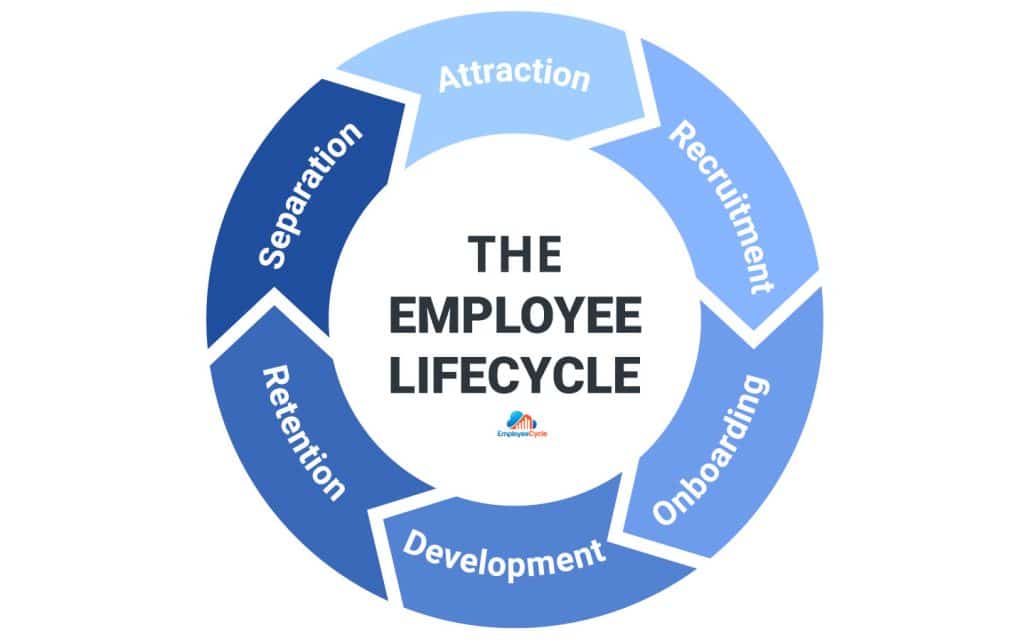Metrics are valuable to the strategic effectiveness of HR. They provide a way to measure the success of your HR team’s initiatives. There are metrics for every stage of the employee life cycle. Of course, don’t forget to follow-up with the analytics once you have the data and metrics.
Here are just a few metrics to consider across the employee lifecycle.

Attraction
The first phase of the employee lifestyle speaks to the process of attracting the right talent to meet your organization’s needs. Your employer brand is key at this stage.
To measure your employer brand, track your ratings on review sites like Glassdoor or Indeed. Recruitment metrics like the number of applications per job or time-to-fill will tell you how many people are interested in your company. Even consider tracking your company’s interactions on social media through mentions and posts. All these will give you an indication of how your company is perceived and its employer brand.
Recruitment
Once you attract quality talent, the second phase is recruiting the right talent for the right role. This is where sourcing, screening, and interviewing come into play.
Recruitment has a wealth of metrics to measure success. Cost-per-hire is valuable for understanding where your spend is occurring and what practices are most cost-effective. Time-to-fill will tell you how long it is taking your recruitment team to fill a role. Longer time-to-fills can either mean breakdowns in your recruitment processes or the team is having a hard time finding talent.
Onboarding
This third phase, onboarding, is a critical step. It ensures the employee is properly acclimated to the organization and their role. Without proper onboarding, employees are not set up for success.
Two great metrics to measure onboarding are time-to-productivity and new hire turnover. Time-to-productivity tells you how long it takes a new hire to get up to speed in their role. New hire turnover tells you how many new hires are leaving the organization. Poor onboarding contributes to higher turnover rates for new hires.
Development
The fourth phase looks at the process of training and developing your employees over the time they are with the organization. Continuous growth is an important concept to value as roles evolve, business needs grow, or industry standards change.
Promotion rates give you an idea of how many people are moving up within your organization, which is a sign of individual growth. A low promotion rate should prompt the question of why your employees are not being promoted. Are they not being developed enough to meet the qualifications?
Retention
Even though it’s listed as the fifth phase, retention is ongoing, just like development. Retention is vital as turnover is a costly and time-consuming problem to have.
This phase has its own metric. The retention rate tells you how many people are staying with the organization over a given period of time. Your engagement rate will also give an indication of your retention. The lower the engagement, the lower your retention.
Separation
The final phase is separation, which isn’t always a negative thing. At some point, all employees will need to leave the organization, whether it be for another opportunity, retirement, or poor fit. It’s key to have an understanding of why people are leaving though.
Measure and track the reasons why your people are leaving. Exit interviews during offboarding, or separation, are the most effective method for collecting this information. People will always say they are leaving for another job. But, the real question is why did they accept that role or choose to start looking for the job in the first place. Additionally, if you have a lot of involuntary terminations, ask why. If it’s the performance, are people not being trained or were they bad hires? If it’s policy violations, are you educating and communicating to your employees effectively?
There are a lot of metrics and for every aspect of the employee’s lifecycle. Tracking and managing those metrics can be daunting and time-consuming. An HR dashboard makes it easier. The tool will automatically calculate your metrics by pulling in the data from your many HR systems. It then creates easy-to-understand visualizations to help you communicate the numbers effectively. An HR dashboard lets you be the strategic business partner to senior leadership that your organization needs.
Sign up today for a free account or get a free live demo of our automated HR dashboard. Spend your time on the analytics, not the calculations and reporting.












